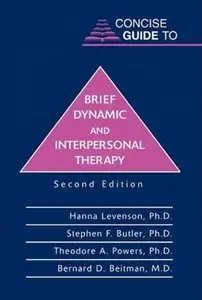Hanna Levenson, Stephen F. Butler, Theodore A. Powers, Bernard D. Beitman - Concise Guide to Brief Dynamic and Interpersonal Therapy (2nd edition)
Published: 2002-06-25 | ISBN: 1585620483 | PDF | 232 pages | 1 MB
In today's world of managed care – characterized by limited mental health resources, emphasis on accountability, concerns of third-party payers, and consumer need – the demand for mental health professionals to use briefer therapeutic approaches is on the rise. Fully 84% of all clinicians are doing some form of planned brief therapy (6-20 sessions per year per patient). Yet despite clinical advances and outcome data that demonstrate the effectiveness of short-term therapy, many therapists – in fact, 90% of those whose theoretical orientation is psychodynamic rather than cognitive-behavioral – are reluctant to learn briefer interventions, seeing value only in long-term, depth-oriented work. The second edition of this Concise Guide is intended to help educate both beginning and experienced clinicians in the strategies and techniques of time-attentive models and to foster more positive and optimistic attitudes toward using these important therapies. * The seven therapeutic models presented here – including an entirely new chapter on time-limited group therapy – highlight the importance of the interpersonal perspective. * The seven models, one per chapter, represent well-established short-term approaches to clinical issues that therapists commonly encounter in their clinical practices. These models also have clearly defined intervention techniques and formulation strategies and can be used within the 10- to 20-session time frame of most managed care settings. * The first part of each chapter dealing with a therapeutic model lists the various presenting problems the authors deem most suitable for treatment by that particular approach. The authors discuss the overall framework of each model, selection criteria, goals, therapeutic tasks and strategies, empirical support, and relevance for managed care, with clinical cases to illustrate the application of each model. The authors include updated chapters on supportive, time-limited, and interpersonal therapies; time-limited dynamic psychotherapy; short-term dynamic therapy for patients with posttraumatic stress disorder; brief dynamic therapy for patients with substance abuse disorders; an entirely new chapter on time-limited group therapy; and a final chapter on the reciprocal relationship between pharmacotherapy and psychotherapy. Meant to complement the more detailed information found in lengthier psychiatric texts, this Concise Guide (it is designed to fit into a jacket or lab coat pocket) is a practical and convenient reference for psychiatrists, psychiatric residents, and medical students working in a variety of treatment settings, such as inpatient psychiatry units, outpatient clinics, consultation-liaison services, and private offices.



